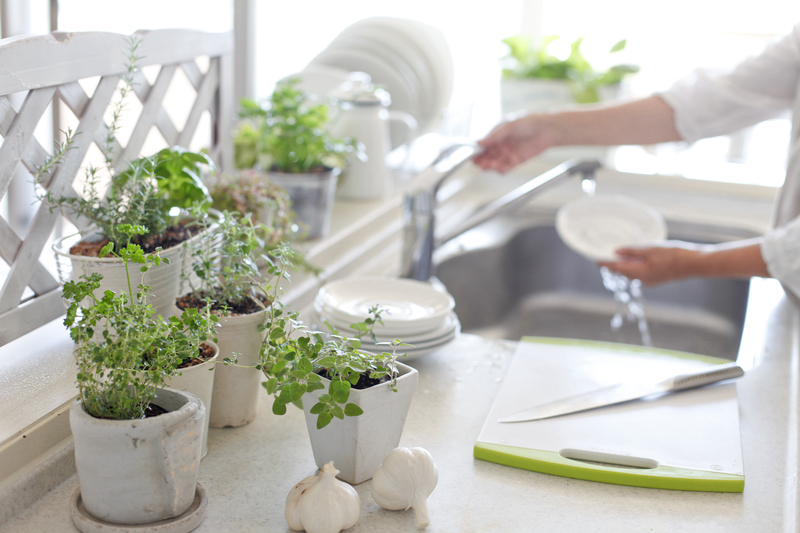Guide to Designing Functional and Aesthetic Garden Seating
Posted on 17/08/2025
Guide to Designing Functional and Aesthetic Garden Seating
Transforming your outdoor space into a beautiful, welcoming sanctuary often revolves around one crucial element: the right garden seating. Whether your ambition is to create a peaceful nook for quiet reflection or an inviting hub for lively gatherings, well-designed seating can make all the difference.

Why Is Garden Seating So Important?
Garden seating serves not only as a functional necessity for comfort but also as an anchor for your landscape's aesthetics and usability. A thoughtfully-designed seating area encourages you--and your guests--to spend more time outdoors, reconnecting with nature while creating cherished memories.
Here's why the right garden bench, chair, or swing matters:
- Enhances usability: Makes outdoor living spaces more inviting and practical.
- Defines zones: Helps structure your garden visually and functionally.
- Expresses style: Lets you showcase your personal taste and aesthetic preferences.
- Maximizes value: High-quality, well-placed garden furniture can increase your home's curb appeal and resale value.
Key Principles of Functional and Aesthetic Outdoor Seating
Before you rush to purchase a new outdoor sofa or bench, it's crucial to consider both functional elements and visual harmony. Achieving a balance ensures your space is not just good-looking but also comfortable, practical, and enduring.
1. Comfort and Ergonomics
- Ergonomic design: Choose seating with supportive backrests, proper height, and ample space for stretching out.
- Cushions & upholstery: Weatherproof cushions soften hard materials and make longer sits possible, without sacrificing durability.
- Armrests & footrests: For lounges and benches, added ergonomic features can vastly improve comfort.
2. Durability and Maintenance
- Material choice: Select materials--like teak, powder-coated steel, recycled plastics, or composite wood--suited for your climate and maintenance preferences.
- Weather resistance: Ensure fabrics and frames can withstand sun, rain, and changes in temperature.
- Easy care: Opt for finishes and treatments that make cleaning a breeze, so your furniture stays attractive year-round.
3. Style and Aesthetics
- Match the landscape: Your garden seating should complement your existing planting schemes, hardscape materials, and architectural features.
- Color harmony: Coordinate cushion and frame colors with your garden's palette for a cohesive look.
- Shape and scale: Reflect how seats interact visually with paths, patios, and planted borders.
Types of Garden Seating: From Classic to Contemporary
Variety is the spice of outdoor living! Understanding the diverse options available will help you select the best garden chairs, benches, or swings tailored to your needs and style.
Benches: Timeless Utility and Style
A classic garden bench is an enduring favorite for its versatility and understated elegance. Benches come in styles ranging from rustic log-built designs to sleek, modern backless forms. Place benches against a wall, under a tree, or along a favorite path for spontaneous rest stops and scenic contemplation.
- Materials: Wood, metal, stone, or composite
- Ideal for: Small and large spaces alike--great for both solitary reflection and communal gatherings
Chairs and Armchairs: Personalized Comfort
Chairs give you the flexibility to rearrange seating for social events or privacy. Armchairs with comfortable backs and arms promote relaxation, while lightweight stackable options make storing a breeze when not in use.
- Ideal for: Patios, decks, and dining zones
- Variations: From Adirondack to bistro styles
Outdoor Sofas and Sectionals: Living Room Luxury
For outdoor entertaining, nothing beats the plush comfort of a weatherproof outdoor sofa or sectional. Arrange them with side tables and ottomans for a seamless transition from indoor to outdoor living.
- Materials: Powder-coated aluminum frames and UV-stabilized cushions
- Perfect for: Larger patios, poolside lounges, and gathering zones
Swings, Hammocks, and Gliders: Whimsical Relaxation
Add a touch of nostalgia and fun with garden swings, hammocks, or gliders. These seating types encourage gentle motion and make your space instantly more inviting to both adults and children.
- Attach to: Porches, sturdy trees, or custom pergolas
- Perfect for: Casual reading nooks, nap zones, or play areas
Built-in Seating: Seamless Integration
Permanent seating, like stone walls topped with cushions or deck-integrated benches, adds architectural interest and maximizes space. These options require more planning but reward you with an ultra-durable, tailored look.
- Best for: Small urban yards, modern courtyards, or multi-level gardens
Location, Location, Location: Smart Placement for Garden Furniture
Even the most visually striking outdoor seat can disappoint if poorly located. Thoughtful placement maximizes sun or shade, preserves privacy, and frames your garden's best views.
Tips for Choosing the Right Spot:
- Sun and shade: Observe how sunlight moves across your garden. Place seating in protected spots for mid-afternoon shade or sunny spots for cooler mornings.
- Views: Orient chairs or benches towards focal points--a flower bed, water feature, or mountain vista.
- Shelter: Use hedges, fences, or arbors to screen your seating from wind and neighbors' gaze.
- Functionality: Keep dining seating near outdoor kitchens or grills. Secluded reading nooks work best at the edge of your plot, away from high-traffic areas.
Choosing the Best Materials for Durability and Beauty
The right materials are critical for combining functionality, comfort, and aesthetics in your garden seating. Below is a breakdown of popular materials and their pros and cons:
Wood
- Pros: Natural warmth, classic style, can be painted or stained
- Cons: Needs regular sealing; some woods (like pine) are less durable without treatment
- Best choices: Teak, cedar, eucalyptus, and acacia for superior lifespan and durability
Metal
- Pros: Sleek and modern, highly durable, minimal maintenance (especially with powder coating)
- Cons: Can be hot in sun, prone to rust if untreated
- Best options: Aluminum (lightweight and rust-free), stainless steel, wrought iron (heavy and traditional look)
Stone and Concrete
- Pros: Hip, contemporary look or classical charm, nearly indestructible
- Cons: Heavy, can be cold and hard without cushions, more permanent placement
Synthetic Materials (Plastic, Resin, Composite)
- Pros: Lightweight, low-maintenance, often budget-friendly, available in many styles and colors
- Cons: May fade over time, less eco-friendly unless recycled
Blending Functionality and Visual Appeal: Design Strategies
A truly great garden seating area combines practicality with artistry. These design strategies can help you achieve maximum comfort and stunning looks:
Layering and Zoning
- Create multiple seating zones: Mix benches, bistro tables, and loungers for different moods and uses.
- Use plant screening: Define spaces with hedges or tall grasses for privacy and ambiance.
Play With Heights and Forms
- Mix informal and formal shapes: Pair curvy, organic benches with geometric modular furniture.
- Incorporate vertical interest: Use pergolas, arbors, or trees to create shade and frame seating areas.
Light It Right
- Accent with soft lighting: String lights, lanterns, and solar LEDs make evening use magical and safer.
- Feature path lighting: Guide guests to your garden furniture and highlight special architectural features.
Personalizing Your Outdoor Seating Sanctuary
While functionality anchors your choices, personal touches transform mere seats into a haven you'll love spending time in. Add color, coziness, and character to create a uniquely yours garden seating area.
Accessories That Add Comfort and Personality
- Weather-resistant cushions and throws: Patterned textiles inject color and warmth.
- Outdoor rugs: Define zones while softening hardscapes.
- Planters and scented blooms: Place fragrant pots near seats for multisensory enjoyment.
- Side tables and trays: Make relaxing easy with surfaces for drinks, books, or snacks.
Seasonal Flexibility
- Storage solutions: Stackable chairs and lightweight tables make off-season storage a cinch.
- Shading options: Add parasols, retractable awnings, or shade sails for hot summer days.
- Winter extension: Fire pits, patio heaters, and blankets can extend outdoor living into cooler months.
Common Mistakes to Avoid When Designing Garden Seating Areas
Even the best intentions can lead to outdoor seating that's underused or uncomfortable. Sidestep these typical pitfalls for superior results:
- Overcrowding: Balance the number of seats with available space for easy movement.
- Neglecting weather: Avoid placing seats in wind tunnels, puddle-prone spots, or full sun without shade.
- Ignoring scale: Ensure seats suit your garden's size. Oversized furniture can overwhelm, while tiny chairs vanish in a large expanse.
- Choosing style over comfort: Ensure ergonomics and support aren't sacrificed for chic looks.

FAQs: Designing the Perfect Garden Seating Area
How much seating do I need?
It depends on how you use your garden. For casual family use, a few benches or loungers may suffice. For frequent entertaining, plan for at least 6-8 seats and flexible arrangements to accommodate guests.
How do I maintain garden furniture?
Wipe down frames regularly, clean spills promptly, and store cushions during adverse weather. Wood seats may need resealing or oiling annually; metals require periodic checks for rust; synthetics generally need only soapy water for cleaning.
Can I create DIY garden seating?
Absolutely! Pallet benches, gabion walls topped with wood planks, or upcycled chairs are budget-friendly and add a personal touch to your space.
Conclusion: Designing Garden Seating That Delights
Designing functional and aesthetic garden seating is about creating outdoor areas that blend comfort, style, and relevance to your landscape. Consider user needs, carefully select materials, layer seating areas, add personal touches, and don't be afraid to get creative. With thoughtful planning, your garden seat becomes more than just a furniture piece--it's an invitation to celebrate, rest, and enjoy the beauty of the outdoors every day.
Ready to get started? Embrace these tips and transform your outdoor seating into the highlight of your garden!

